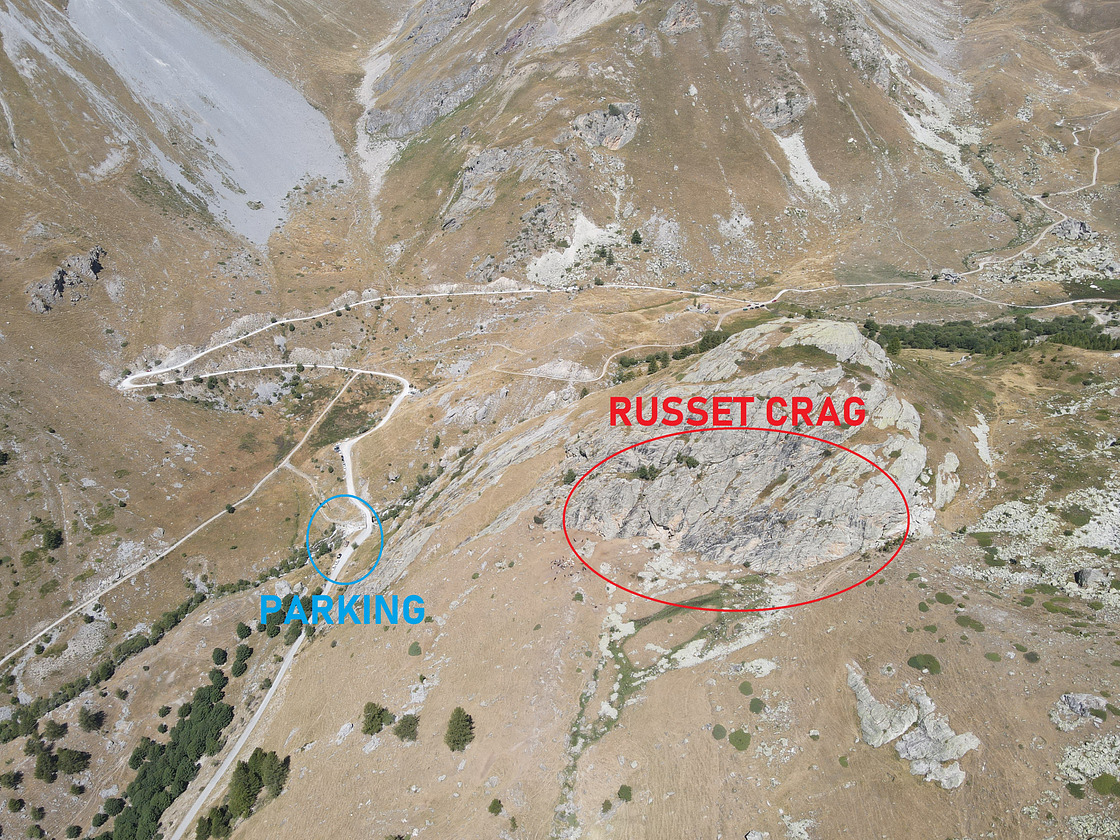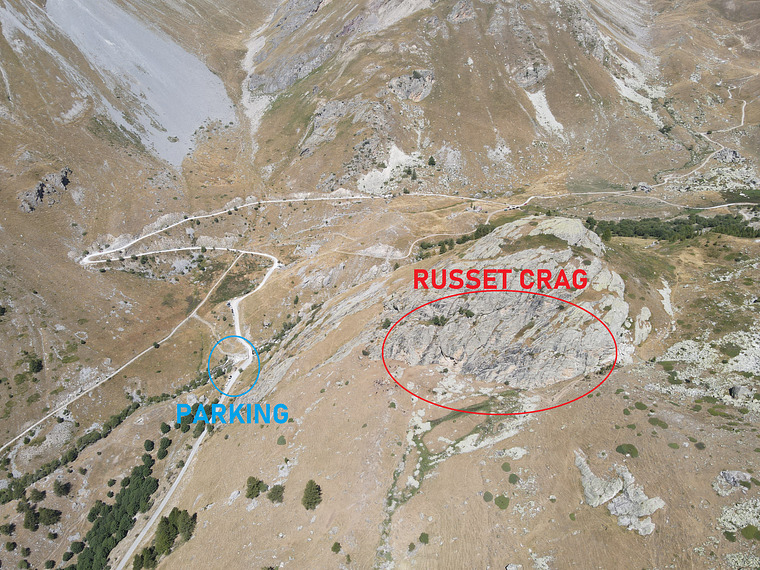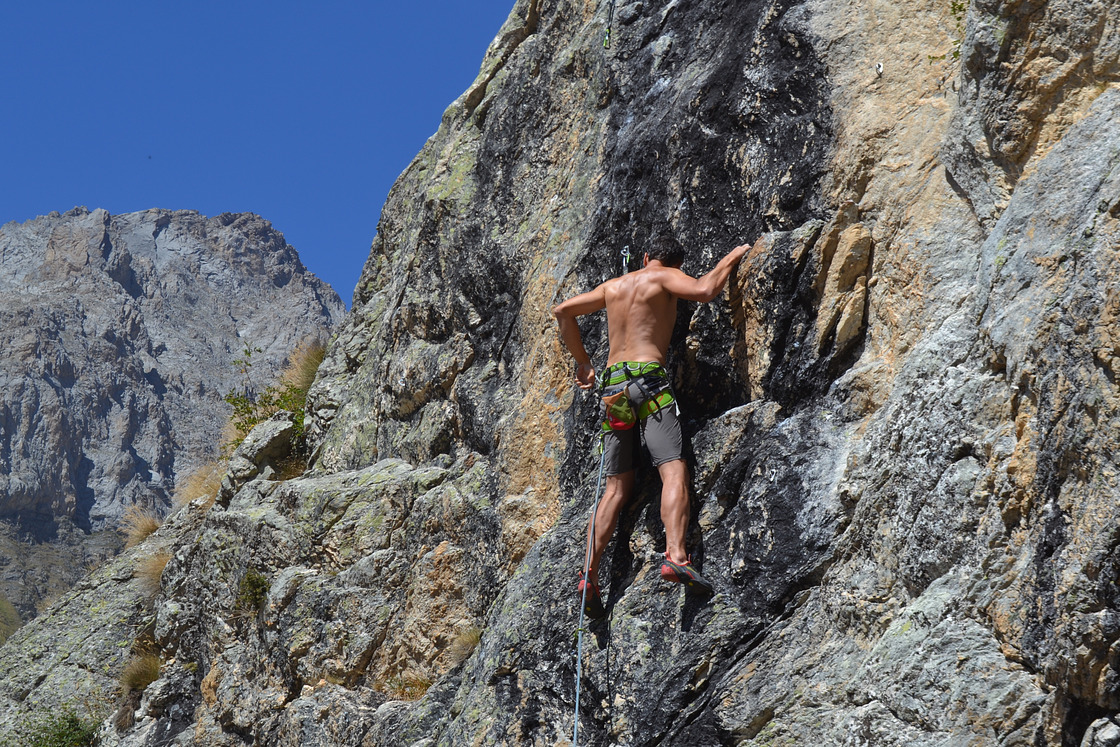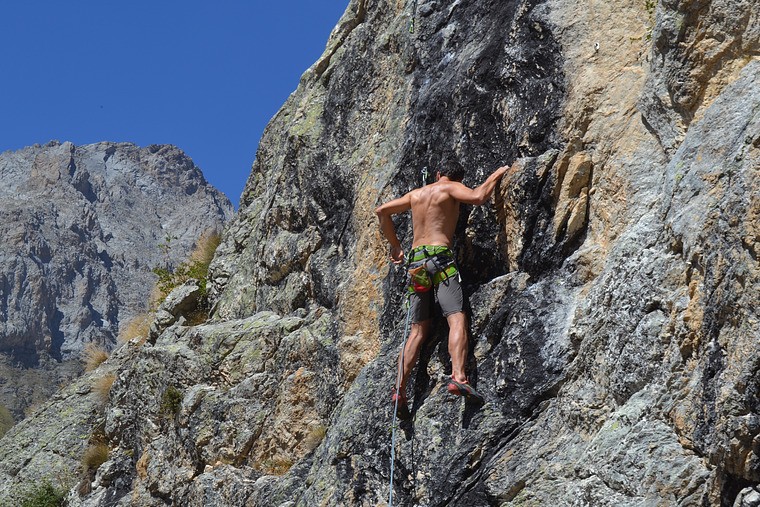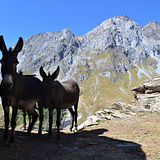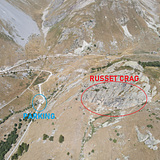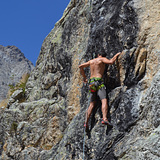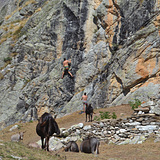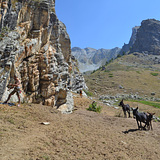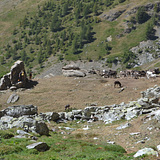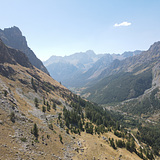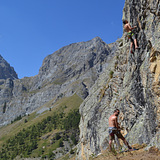☀️SUN DURING THE DAY: The crag is always in the sun
🧭 EXPOSURE: • South-Est
🧱 ROCK TYPE: The rock here is Quartzite.
🚶🏻 APPROACH TIME: 10-15 minutes.
📆 BEST PERIOD: May to October : 05-10
Altitude : 2000 meters
👪 FAMILY FRIENDLY: YES
📱 PHONE SIGNAL: YES
🇬🇧
⛰️The Russet cliff is located at the end of the Maira Valley, on the right side. With its orange coloration, it catches attention from the road. The rock is mainly quartzite, and in the orange part, it is almost devoid of grip, making the climbing technically and physically demanding. The wall offers holds of various sizes, and the incline varies from slightly inclined slab to overhang. This variation in steepness is reflected in the difficulty levels of the routes, ranging from 4a to 8a+.
The cliff is exposed to the southeast, making it ideal during colder periods. The routes are primarily athletic in nature, providing an excellent testing ground for climbers who intend to later tackle the higher peaks of the Valley due to the similarity in rock type. Training on this type of rock is an excellent preparation for more challenging endeavors.
At the base of the cliff, there is a very characteristic natural water source. The surrounding panorama is breathtaking and surely won't disappoint even the most discerning enthusiasts of mountain landscapes.
🇮🇹
⛰️ La falesia di Russet è collocata in fondo alla Valle Maira, sul versante destro. Con la sua colorazione arancione, attira l'attenzione già dalla strada. La roccia è principalmente quarzite, e nella parte arancione è quasi priva di aderenza, rendendo così la scalata tecnica e fisicamente impegnativa. La parete offre tacche di varie dimensioni e la pendenza varia da placca leggermente inclinata a strapiombo. Questa variazione di pendenza si riflette nei gradi delle vie, che vanno dal 4a all'8a+.
L'esposizione della falesia è a sud-est, rendendola ideale durante i periodi più freddi. Le vie sono principalmente di carattere atletico, offrendo un ottimo terreno di prova per scalatori che intendono poi affrontare le vette più alte della Valle data l'ugualianza di tipologia di roccia. L'allenamento su questo tipo di roccia è un'ottima preparazione per sfide più impegnative.
Alla base della falesia si trova una sorgente d'acqua nativa molto caratteristica. Il panorama circostante è mozzafiato e sicuramente non deluderà nemmeno i più esigenti appassionati di paesaggi montani.
🇩🇪
⛰️Die Felswand von Russet befindet sich am Ende des Maira-Tals auf der rechten Seite. Mit ihrer orangefarbenen Färbung fällt sie bereits von der Straße aus auf. Der Fels besteht hauptsächlich aus Quarzit, und im orangefarbenen Bereich fehlt es fast an Haftung, was das Klettern technisch und körperlich anspruchsvoll macht. Die Wand bietet Griffe in verschiedenen Größen, und die Neigung variiert von leicht geneigter Platte bis hin zum Überhang. Diese Variation in der Steilheit spiegelt sich in den Schwierigkeitsgraden der Routen wider, die von 4a bis 8a+ reichen.
Die Felswand ist nach Südosten ausgerichtet, was sie während kälterer Perioden ideal macht. Die Routen sind hauptsächlich athletisch und bieten einen ausgezeichneten Testgrund für Kletterer, die beabsichtigen, später die höheren Gipfel des Tals aufgrund der Ähnlichkeit im Gesteinstyp zu erklimmen. Das Training auf dieser Art von Fels ist eine hervorragende Vorbereitung auf anspruchsvollere Unternehmungen.
Am Fuß der Felswand befindet sich eine sehr charakteristische natürliche Wasserquelle. Die umliegende Panoramaaussicht ist atemberaubend und wird sicherlich selbst die anspruchsvollsten Enthusiasten von Berglandschaften nicht enttäuschen.
🇬🇧
⏪⌚The Russet cliff has an interesting history of development. It was initially bolted in the distant year of 2011 by a group of passionate local climbers. In that year, around twenty climbing routes were established on both sides of the wall: both on the right and on the left. This collective effort gave birth to a place of challenge and adventure for climbing enthusiasts.
A significant chapter in the history of this cliff opened in 2020 when Giovannino Massari added a dozen new lines on the left side of the sector. This expansion further enriched the climbing opportunities offered by the cliff. Massari's contribution expanded the possibilities for climbers to experience new challenges and to test their skills on fresh climbing routes.
Today, the Russet cliff represents not only a technical and physical challenge but also a place where the passion for climbing and the commitment to the climbing community come together. The combined efforts of the original route setters and subsequent contributors like Giovannino Massari have helped make this cliff a landmark for climbing enthusiasts in the region.
🇮🇹
⏪⌚La falesia di Russet ha una storia di sviluppo interessante. È stata inizialmente attrezzata nel lontano 2011 da un gruppo di scalatori locali appassionati. In quell'anno, sono state create circa venti vie di arrampicata su entrambi i lati della parete: sia sulla destra che sulla sinistra. Questo sforzo collettivo ha dato vita a un luogo di sfida e avventura per gli appassionati di scalata.
Un capitolo significativo nella storia di questa falesia si è aperto nel 2020, quando Giovannino Massari ha aggiunto una dozzina di nuove linee sulla parte sinistra del settore. Questa espansione ha arricchito ulteriormente le opportunità di arrampicata offerte dalla falesia. L'apporto di Massari ha ampliato le possibilità per gli scalatori di sperimentare nuove sfide e di mettere alla prova le proprie abilità su vie fresche di arrampicata.
Oggi, la falesia di Russet rappresenta non solo una sfida tecnica e fisica, ma anche un luogo in cui la passione per l'arrampicata e l'impegno nella comunità scalatrice si fondono. Gli sforzi congiunti degli equipaggiatori originali e dei successivi contributori, come Giovannino Massari, hanno contribuito a rendere questa falesia un luogo emblematico per gli amanti della scalata nella regione.
🇩🇪
⏪⌚Die Felswand von Russet hat eine interessante Entwicklungsgeschichte. Sie wurde zunächst im entfernten Jahr 2011 von einer Gruppe leidenschaftlicher lokaler Kletterer mit Bohrhaken versehen. In diesem Jahr wurden etwa zwanzig Kletterrouten auf beiden Seiten der Wand eingerichtet: sowohl auf der rechten als auch auf der linken Seite. Diese gemeinsame Anstrengung brachte einen Ort der Herausforderung und Abenteuer für Kletterenthusiasten hervor.
Ein bedeutsames Kapitel in der Geschichte dieser Felswand eröffnete sich im Jahr 2020, als Giovannino Massari auf der linken Seite des Sektors ein Dutzend neue Routen hinzufügte. Diese Erweiterung bereicherte die Klettermöglichkeiten, die von der Felswand geboten werden, weiter. Massaris Beitrag erweiterte die Möglichkeiten für Kletterer, sich neuen Herausforderungen zu stellen und ihre Fähigkeiten auf frischen Kletterrouten zu testen.
Heute repräsentiert die Felswand von Russet nicht nur eine technische und physische Herausforderung, sondern auch einen Ort, an dem die Leidenschaft für das Klettern und das Engagement für die Klettergemeinschaft zusammenkommen. Die gemeinsamen Anstrengungen der ursprünglichen Routenerschließer und nachfolgender Mitwirkender wie Giovannino Massari haben dazu beigetragen, diese Felswand zu einem Wahrzeichen für Kletterbegeisterte in der Region zu machen.
